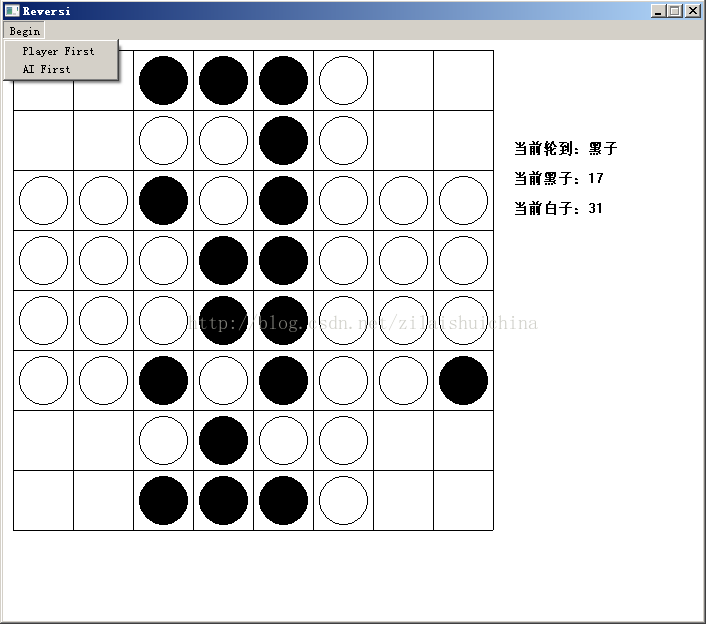游戏开发(三)——WIN32 黑白棋(一)——棋局逻辑的设计
2020-12-13 05:36
标签:游戏设计 win32 黑白棋 游戏开发 今天以黑白棋为例,开始给一个win32的小游戏设计, 这里打算分3部分介绍 1、棋盘,棋局的现实 2、玩家、AI的现实(且听下回分解) 3、游戏画面的现实(且听下下回分解) 其中第一部分为黑白棋游戏的主要逻辑: 1、棋盘,以及棋盘上的棋子的存储形式。这里用到了位图。 2、是否可以落子的判断(黑白棋是只有你落子的位置,在横竖斜八个方向中任意一个方向,能吃掉对方的子,你才可以落在该位置,八个方向都吃不掉对方子的位置是不能下的),以及吃子的逻辑(吃子的逻辑同样是八个方向,两个己方棋子之间夹住的对方棋子,可以被吃掉,翻转为己方棋子)。这里为了使得代码简介一点,使用了函数指针(不同方向上坐标的变化逻辑不一样)。 3、某一方下了一个子之后,交换手的判断(黑白棋中存在可能,一方下了一个子,并吃掉对方的子,之后对方无子可下,没有一个位置能使得对方能吃掉己方的棋子,所以黑白棋并不一定始终是一人一步来的,它可能存在一方连续落子的情况)。 4、记录玩家每一步下棋的步骤,使得可以悔棋(只悔玩家,不悔AI)。 5、游戏是否结束的判断(由于存在无子可下的情况,有可能双方都无子可以下,即一方将另一方全部吃光,所以黑白棋不一定是下满棋盘才分出胜负)。 第二部分主要为了写AI: 黑白棋的AI其实蛮复杂,有专门的研究黑白棋的AI的算法文章,这里只简单介绍一下,也涉及到几个概念:稳定子、行动力、等,具体在第二部分介绍。 第三部分主要是游戏画面的显示,涉及到windows消息机制,鼠标事件,键盘事件,菜单事件,定时器事件;以及简单的图形、文字绘制,涉及到画笔、画刷填充、绘图层HDC、画线、画圆、显示文字、双缓冲的位图拷贝。 阅读第三部分前,读者可以先行阅读《windows程序设计》一书打个基础。 也可以看完博文之后,再将涉及到的图形API,消息机制等windows程序设计中涉及到的点带回到书中去详细了解。 ps:只看1、3部分,同样可以实现一个黑白棋,只是没有AI,就只能人跟人下 黑白棋游戏在设计中需要注意的几点: 1、惯例,首先要定义好棋盘的坐标,定义为左上角那一格为(0,0),向右为x正方向,向下为y正方向,黑白棋棋盘是一个8*8的棋盘,所以定义两个常量表示: 3、棋盘的表示,位图 4、棋盘上一个位置的设计,因为这里涉及到位置(即坐标)的八方向移动的逻辑,因此将坐标位置单独抽象出来,实现坐标的上下左右以及斜的四方向的坐标变化,然后将其重定义为函数指针,使得后面在坐标变化时,不用switch...case八种情况,而是可以将方向当成参数。 7、判断某个位置是否可以落子 8、判断某一方是否可以落子 9、落一个子之后的吃子 10、下棋的步骤,为了可以悔棋 落子的时候,填一下ReversiStep,存入链表,悔棋的时候,从链表尾退出一个节点,并将棋盘状态恢复为这个尾节点的状态,即实现了悔棋 一盘棋总共60步下满,这里用了一个对象池,一次性申请好60步所需内存,这样避免在频繁的落子悔棋的过程中,频繁的申请内存 11、最后,判断游戏是否结束的逻辑,即双方都无子可下,则游戏结束 先给个游戏截图吧 下面先贴出第一部分的代码 ReversiCommon.h
游戏开发(三)——WIN32 黑白棋(一)——棋局逻辑的设计,搜素材,soscw.com 游戏开发(三)——WIN32 黑白棋(一)——棋局逻辑的设计 标签:游戏设计 win32 黑白棋 游戏开发 原文地址:http://blog.csdn.net/zilaishuichina/article/details/38235313const int REVERSI_MAX_ROW = 8;
const int REVERSI_MAX_COLUMN = 8;
2、棋盘上棋子的类型分三种:黑子,白子,空白无子,枚举表示
enum EnumReversiPiecesType
{
enum_ReversiPieces_Null = 0x00,
enum_ReversiPieces_Black = 0x01,
enum_ReversiPieces_White = 0x02,
};
这三种情况,其实用2位2进制即可表示,一行8个位置就是16位2进制,就是一个WORD就足够了,所以:
TArray1
位图是8行,每行是一个WORD,这个TArray1是之前实现的一维数组模板直接用的
typedef void (ReversiPoint::*ReversiPointForward)();
5、某一方的棋子,在某一坐标位置,向某一方向,是否可以吃掉对方的棋子的判断
bool ReversiCheck(EnumReversiPiecesType type, char row_y, char column_x, ReversiPointForward forward);
是否可以吃子的伪代码:
定义一个坐标对象point,初值为当前点row_y, column_x
记录该方向上的搜索次数search,初值为0
point向forward方向移动
搜索次数search++
while (point是一个合法的坐标,不能移出棋盘外面去了)
{
取point当前位置的棋子类型
(此时已经是forward移动一次之后的位置了,不是row_y, column_x了)
if (当前位置有棋子)
{
if (当前位置的棋子类型等于传入参数type,type就是要下的棋子类型)
{
if (搜索次数search大于1次)
{
说明找到的同色棋子与当前棋子坐标差超过1,point至少移动了2次
则两子之间夹有不同色的棋子
符合翻转规则,return true
}
else
{
说明找到的同色棋子与当前棋子,两子是紧挨着的
该方向两子之间无子可以翻转
不符合翻转规则,return false
}
}
else
{
说明找到的是不同色的棋子,继续向下一个位置搜
point向forward方向移动
搜索次数search++
}
}
else
{
一直找到空位也没找到,该方向没有同色棋子,无法翻转
}
}
超出棋盘范围都没有找到同色棋子,该方向没有同色棋子,无法翻转
6、某一方的棋子,在某一坐标位置,向某一方向,吃掉对方的棋子
void DoReversi(EnumReversiPiecesType type, char row_y, char column_x, ReversiPointForward forward);
伪代码实现
定义一个坐标对象point,初值为当前点row_y, column_x
point向forward方向移动
while (point是一个合法的坐标,不能移出棋盘外面去了)
{
取point当前位置的棋子类型
(此时已经是forward移动一次之后的位置了,不是row_y, column_x了)
if (当前位置的棋子类型不等于传入参数type,type就是下的棋子类型)
{
将该位置的棋子类型翻转为type一方的棋子
point向forward方向移动
因为在翻转之前做了ReversiCheck的判断
即这个方向肯定是符合翻转规则,有子可吃的
所以这里不再判断当前位置的棋子类型是否为空
}
}
有了上面两个基本函数
bool ReversiCheck(EnumReversiPiecesType type, char row_y, char column_x);
则是分别调用上面的ReversiCheck,然后forward传入不同的方向
bool CanPlay(EnumReversiPiecesType type);
即遍历棋盘每一个位置,任意一个位置可以落子,则该方可以落子
void DoReversi(EnumReversiPiecesType type, char row_y, char column_x);
则是分别调用上面的DoReversi,然后forward传入不同的方向
typedef struct ReversiStep
{
ReversiBitBoard m_LastMap;
EnumReversiPiecesType m_CurrType;
ReversiStep& operator= (const ReversiStep& temp)
{
m_CurrType = temp.m_CurrType;
m_LastMap = temp.m_LastMap;
return *this;
}
}ReversiStep;
这里直接记录落子之前的棋盘状态,以及当前这一步是谁落得子就可以了,悔棋的时候就是恢复棋盘状态到这个人落子之前的状态,然后仍然由该玩家重新落子

#ifndef _ReversiCommon_h_
#define _ReversiCommon_h_
//棋盘大小
const int REVERSI_MAX_ROW = 8;
const int REVERSI_MAX_COLUMN = 8;
enum EnumReversiPiecesType
{
enum_ReversiPieces_Null = 0x00,
enum_ReversiPieces_Black = 0x01,
enum_ReversiPieces_White = 0x02,
};
enum EnumReversiResult
{
enum_Reversi_Playing = 0,
enum_Reversi_Draw,
enum_Reversi_Win_Black,
enum_Reversi_Win_White,
};
#endif
ReversiPoint.h
#ifndef _ReversiPoint_h_
#define _ReversiPoint_h_
#include "ReversiCommon.h"
typedef struct ReversiPoint
{
char m_row_y;
char m_column_x;
ReversiPoint& operator= (const ReversiPoint& temp)
{
m_row_y = temp.m_row_y;
m_column_x = temp.m_column_x;
return *this;
}
bool operator!= (const ReversiPoint& temp)
{
if (m_row_y == temp.m_row_y &&
m_column_x == temp.m_column_x)
{
return false;
}
else
{
return true;
}
}
bool IsValid()
{
if (0
ReversiBitBoard.h
#ifndef _ReversiBitBoard_h_
#define _ReversiBitBoard_h_
#include
ReversiBitBoard.cpp
#include "ReversiBitBoard.h"
ReversiBitBoard::ReversiBitBoard()
{
for (int i = 0; i > (column_x * 2);
if (enum_ReversiPieces_Black == oldtype)
{
m_BlackCount--;
}
else if (enum_ReversiPieces_White == oldtype)
{
m_WhiteCount--;
}
m_Map[row_y] = m_Map[row_y] & (~(0x0003 > (column_x * 2);
EnumReversiPiecesType type = static_cast
Reversi.h
#ifndef _Reversi_
#define _Reversi_
#include "TBDLinkList.h"
#include "TObjectPool.h"
#include "ReversiCommon.h"
#include "ReversiBitBoard.h"
#include "ReversiPoint.h"
typedef struct ReversiStep
{
ReversiBitBoard m_LastMap;
EnumReversiPiecesType m_CurrType;
ReversiStep& operator= (const ReversiStep& temp)
{
m_CurrType = temp.m_CurrType;
m_LastMap = temp.m_LastMap;
return *this;
}
}ReversiStep;
class Reversi
{
public:
Reversi();
~Reversi();
void Init();
bool CanPlay(EnumReversiPiecesType type);
bool CanPlay(EnumReversiPiecesType type, char row_y, char column_x);
void DoReversi(EnumReversiPiecesType type, char row_y, char column_x);
bool ReversiCheck(EnumReversiPiecesType type, char row_y, char column_x);
void AddReversiStep();
void Cancel();
void SwapPlayer();
EnumReversiResult IsGameOver();
EnumReversiPiecesType GetCurrType();
ReversiBitBoard& GetMap();
private:
void DoReversi(EnumReversiPiecesType type, char row_y, char column_x,
ReversiPointForward forward);
bool ReversiCheck(EnumReversiPiecesType type, char row_y, char column_x,
ReversiPointForward forward);
EnumReversiPiecesType m_CurrType;
ReversiBitBoard m_ReversiMap;
TBDLinkList
Reversi.cpp
#include "Reversi.h"
Reversi::Reversi()
{
}
Reversi::~Reversi()
{
}
void Reversi::Init()
{
m_CurrType = enum_ReversiPieces_Black;//规定黑先
m_ReversiStepList.Init(enum_DisableLock);
m_ReversiStepPool.Init(REVERSI_MAX_ROW * REVERSI_MAX_COLUMN,
0,
enum_DisableLock_ObjPool,
enum_DisableAssign_ObjPool);
for (int i = 0; i 1)
{
//找到的同色棋子与当前棋子坐标差超过1,则两子之间夹有不同色的棋子
return true;
}
else
{
//否则两子是紧挨着的,该方向两子之间无子可以翻转
return false;
}
}
else
{
//找到的是不同色的棋子,继续
(point.*forward)();
search++;
}
}
else
{
//一直找到空位也没找到,该方向没有同色棋子,无法翻转
return false;
}
}
//超出棋盘范围都没有找到同色棋子,该方向没有同色棋子,无法翻转
return false;
}
void Reversi::DoReversi(EnumReversiPiecesType type,
char row_y, char column_x)
{
if (ReversiCheck(type, row_y, column_x, &ReversiPoint::UL))
{
DoReversi(type, row_y, column_x, &ReversiPoint::UL);
}
if (ReversiCheck(type, row_y, column_x, &ReversiPoint::U))
{
DoReversi(type, row_y, column_x, &ReversiPoint::U);
}
if (ReversiCheck(type, row_y, column_x, &ReversiPoint::UR))
{
DoReversi(type, row_y, column_x, &ReversiPoint::UR);
}
if (ReversiCheck(type, row_y, column_x, &ReversiPoint::L))
{
DoReversi(type, row_y, column_x, &ReversiPoint::L);
}
if (ReversiCheck(type, row_y, column_x, &ReversiPoint::R))
{
DoReversi(type, row_y, column_x, &ReversiPoint::R);
}
if (ReversiCheck(type, row_y, column_x, &ReversiPoint::DL))
{
DoReversi(type, row_y, column_x, &ReversiPoint::DL);
}
if (ReversiCheck(type, row_y, column_x, &ReversiPoint::D))
{
DoReversi(type, row_y, column_x, &ReversiPoint::D);
}
if (ReversiCheck(type, row_y, column_x, &ReversiPoint::DR))
{
DoReversi(type, row_y, column_x, &ReversiPoint::DR);
}
}
void Reversi::DoReversi(EnumReversiPiecesType type,
char row_y, char column_x,
ReversiPointForward forward)
{
ReversiPoint point = {row_y, column_x};
(point.*forward)();
while(point.IsValid())
{
if (type != m_ReversiMap.GetPieces(point.m_row_y, point.m_column_x))
{
m_ReversiMap.SetPieces(type, point.m_row_y, point.m_column_x);
(point.*forward)();
}
else
{
break;
}
}
}
void Reversi::AddReversiStep()
{
TBDLinker
文章标题:游戏开发(三)——WIN32 黑白棋(一)——棋局逻辑的设计
文章链接:http://soscw.com/essay/31307.html